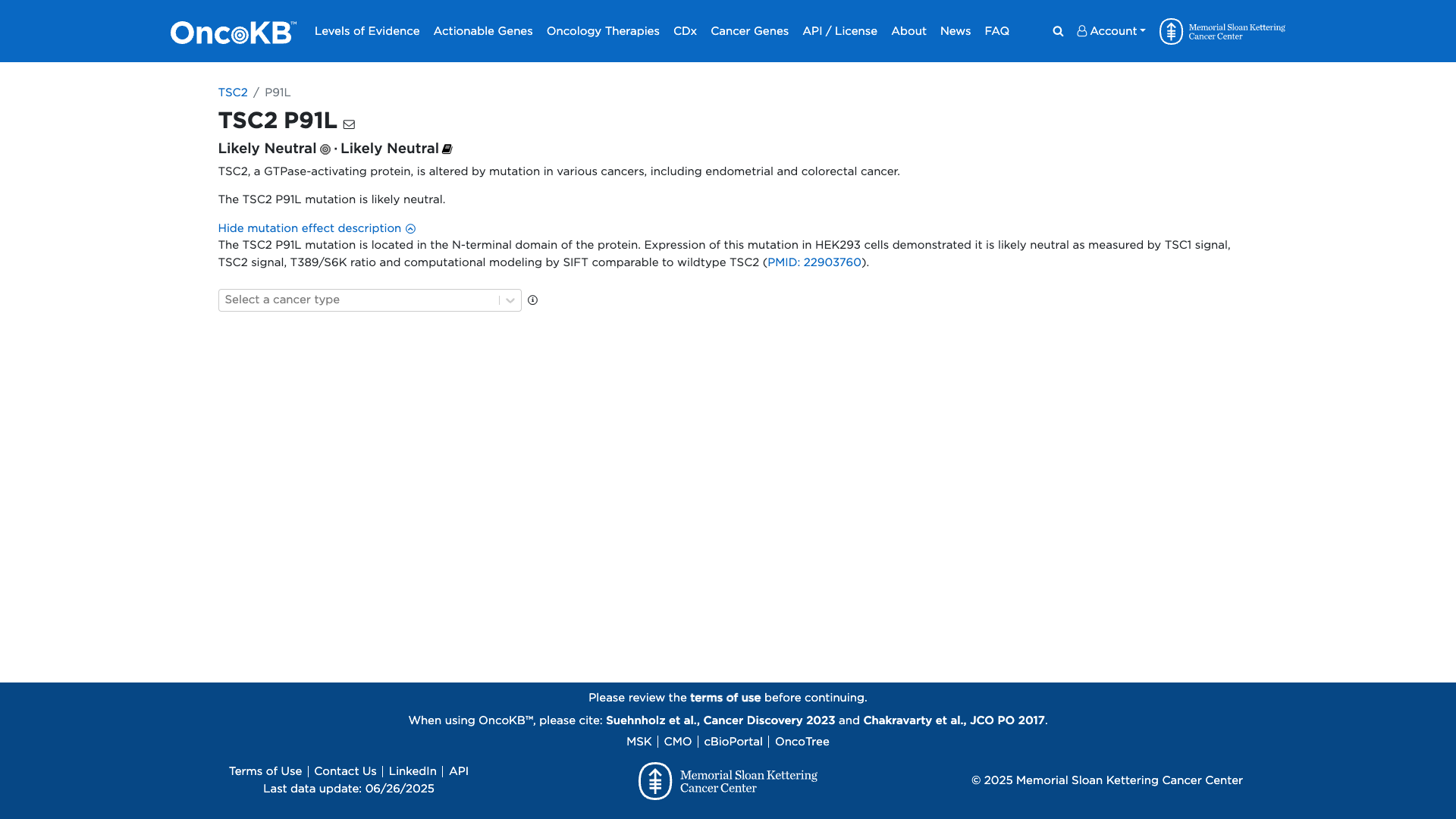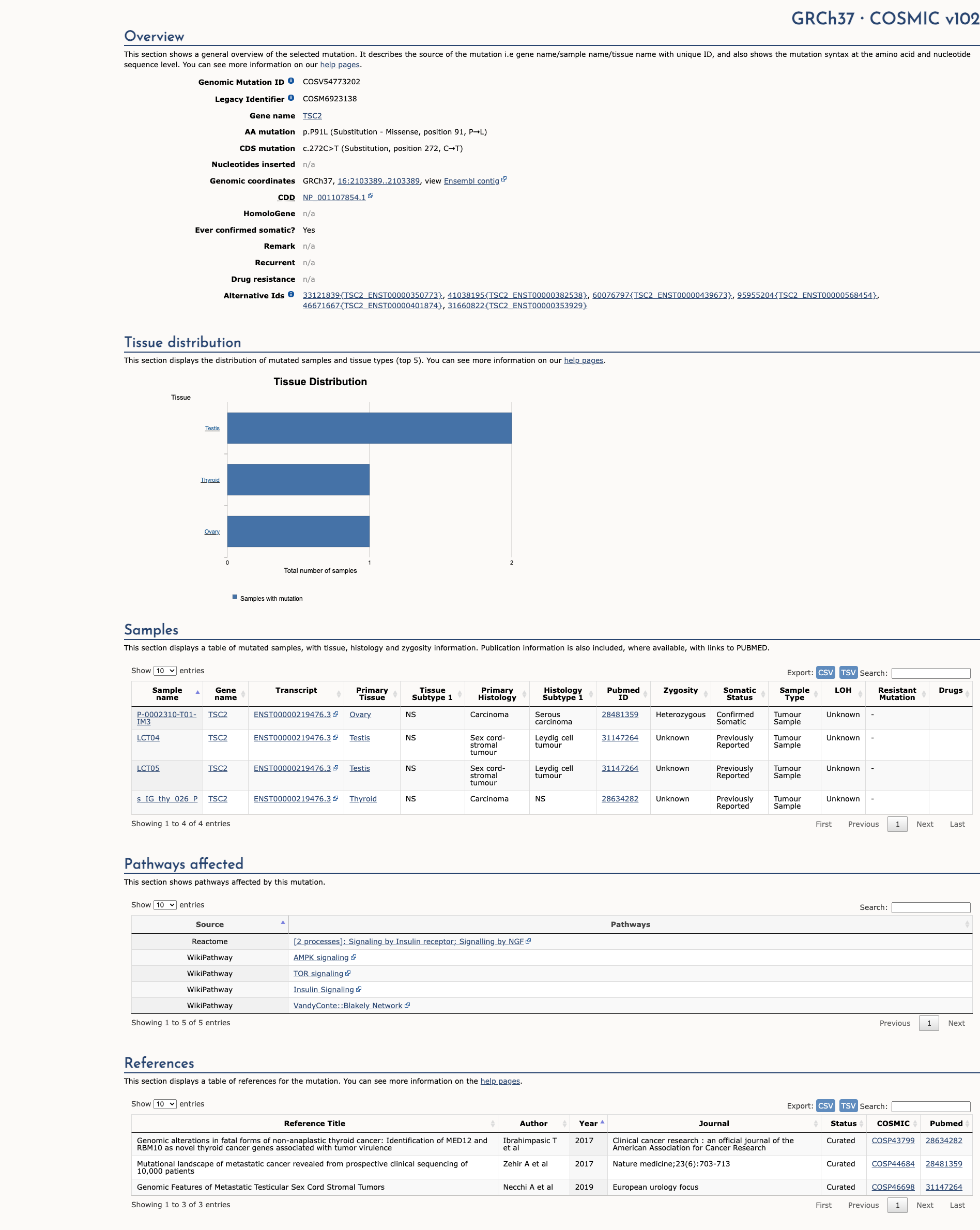TSC2 c.272C>T, p.Pro91Leu
NM_000548.5:c.272C>T
COSMIC ID: COSM6923138, COSM6923139
Likely Benign
The variant c.272C>T (P91L) in TSC2 shows a low population frequency (PM2), well-established functional studies demonstrating no damaging effect (BS3), computational predictions supporting benign impact (BP4), and reputable database classifications as benign (BP6). The overall evidence supports a Likely Benign classification.
ACMG/AMP Criteria Applied
PM2
BS3
BP4
BP6
Genetic Information
Gene & Transcript Details
Gene
TSC2
Transcript
NM_000548.5
MANE Select
Total Exons
42
Strand
Forward (+)
Reference Sequence
NC_000016.9
Alternative Transcripts
| ID | Status | Details |
|---|---|---|
| NM_000548.2 | Alternative | 41 exons | Forward |
| NM_000548.3 | Alternative | 42 exons | Forward |
| NM_000548.4 | Alternative | 42 exons | Forward |
Variant Details
HGVS Notation
NM_000548.5:c.272C>T
Protein Change
P91L
Location
Exon 4
(Exon 4 of 42)
5'Exon Structure (42 total)3'
Functional Consequence
Loss of Function
Related Variants
No evidence of other pathogenic variants at position 91 in gene TSC2
Alternate Identifiers
COSM6923138, COSM6923139
Variant interpretation based on transcript NM_000548.5
Genome Browser
Loading genome browser...
HGVS InputNM_000548:c.272C>T
Active Tracks
ConservationRefSeqClinVargnomAD
Navigation tips: Use mouse to drag and zoom. Click on features for details.
Clinical Data
Global Frequency
0.0852%
Common
Highest in Population
Ashkenazi Jewish
1.56%
Common
Global: 0.0852%
Ashkenazi Jewish: 1.56%
0%
0.05%
0.1%
1%
5%
10%+
Allele Information
Total: 243050Alt: 207Homozygotes: 1
ACMG Criteria Applied
PM2
This variant is present in gnomAD (MAF= 0.0852%, 207/243050 alleles, homozygotes = 1) and at a higher frequency in the Ashkenazi Jewish population (MAF= 1.56%, 149/9534 alleles, homozygotes = 1). The variant is rare (MAF < 0.1%), supporting PM2 criterion application.
Classification
2 publications
Likely Benign
Based on 14 submitter reviews in ClinVar
Submitter Breakdown
1 LB
13 B
Pathogenic
Likely Path.
VUS
Likely Benign
Benign
Publications (2)
Clinical Statement
This variant has been reported in ClinVar as Benign (13 clinical laboratories) and as Likely benign (1 clinical laboratories).
Functional Impact
Functional Domain
Hotspot Status
Not a hotspot
Domain Summary
This variant is not located in a mutational hotspot or critical domain (0 mutations).
Related Variants in This Domain
No evidence of other pathogenic variants at position 91 in gene TSC2
Functional Summary
The TSC2 P91L variant has been functionally characterized and is likely neutral. Experimental expression in HEK293 cells showed that the variant does not significantly alter TSC1 or TSC2 signaling, nor the T389/S6K ratio, and computational modeling supports this neutral effect.
Database Previews
OncoKB

JAX-CKB

Click on previews to view full database entries. External databases may require institutional access.
Computational Analysis
Pathogenicity Predictions
REVEL Score
0.496
0.496
Likely Benign0.0
Uncertain (Low)0.2
Uncertain (Med)0.5
Likely Pathogenic0.75
REVEL scores ≥ 0.75 are strong evidence (PP3)
Predictor Consensus
Mixed/VUS
PP3 Applied
No
Additional Predictors
Pathogenic:
polyphen_prediction: probably_damaging
Benign:
CADD: 4.98metasvm: Tmetalr: Tprimateai: T
Neutral: Show all
VCEP Guidelines
Applied ACMG/AMP Criteria (VCEP Specific)
PVS1
PVS1 (Not Applied) Strength Modified
According to standard ACMG guidelines, the rule for PVS1 is: "Null variant in a gene where loss of function (LoF) is a known mechanism of disease". The evidence for this variant shows it is a missense change (P91L), not a null variant. Therefore, this criterion is not applied.
PS1
PS1 (Not Applied) Strength Modified
According to standard ACMG guidelines, the rule for PS1 is: "Same amino acid change as a previously established pathogenic variant regardless of nucleotide change". The evidence for this variant shows no previously established pathogenic variant at amino acid position 91. Therefore, this criterion is not applied.
PS2
PS2 (Not Applied) Strength Modified
According to standard ACMG guidelines, the rule for PS2 is: "De novo (both maternity and paternity confirmed) in a patient with the disease and no family history". There is no de novo data available for this variant. Therefore, this criterion is not applied.
PS3
PS3 (Not Applied) Strength Modified
According to standard ACMG guidelines, the rule for PS3 is: "Well-established functional studies supportive of a damaging effect on the gene or gene product". The evidence for this variant shows functional studies in HEK293 cells demonstrate no damaging effect on TSC1/TSC2 signaling or S6K phosphorylation. Therefore, this criterion is not applied.
PS4
PS4 (Not Applied) Strength Modified
According to standard ACMG guidelines, the rule for PS4 is: "The prevalence of the variant in affected individuals is significantly increased compared with controls". There are no case-control data demonstrating increased prevalence in affected individuals. Therefore, this criterion is not applied.
PM1
PM1 (Not Applied) Strength Modified
According to standard ACMG guidelines, the rule for PM1 is: "Located in a mutational hot spot and/or well-established functional domain without benign variation". The evidence for this variant shows no indication that P91 lies within a mutational hot spot or critical functional domain. Therefore, this criterion is not applied.
PM2
PM2 (Moderate)
According to standard ACMG guidelines, the rule for PM2 is: "Absent from controls (or at extremely low frequency if recessive)". The evidence for this variant shows a very low overall allele frequency (MAF=0.0852% in gnomAD) and virtual absence in most populations. Therefore, this criterion is applied at Moderate strength because the variant is observed at an extremely low frequency in controls.
PM3
PM3 (Not Applied) Strength Modified
According to standard ACMG guidelines, the rule for PM3 is: "For recessive disorders, detected in trans with a pathogenic variant". This is an autosomal dominant disorder and no trans observations have been reported. Therefore, this criterion is not applied.
PM4
PM4 (Not Applied) Strength Modified
According to standard ACMG guidelines, the rule for PM4 is: "Protein length changes due to in-frame deletions/insertions or stop-loss variants". This variant is a missense substitution with no change in protein length. Therefore, this criterion is not applied.
PM5
PM5 (Not Applied) Strength Modified
According to standard ACMG guidelines, the rule for PM5 is: "Novel missense change at an amino acid residue where a different pathogenic missense change has been seen before". There are no known pathogenic missense changes at residue 91. Therefore, this criterion is not applied.
PM6
PM6 (Not Applied) Strength Modified
According to standard ACMG guidelines, the rule for PM6 is: "Assumed de novo, without confirmation of paternity and maternity". No de novo data are available. Therefore, this criterion is not applied.
PP1
PP1 (Not Applied) Strength Modified
According to standard ACMG guidelines, the rule for PP1 is: "Co-segregation with disease in multiple affected family members". No family segregation data are available. Therefore, this criterion is not applied.
PP2
PP2 (Not Applied) Strength Modified
According to standard ACMG guidelines, the rule for PP2 is: "Missense variant in a gene with a low rate of benign missense variation where missense variants are a common mechanism of disease". TSC2 has numerous missense pathogenic variants and a substantial background of benign variation, so this criterion is not applicable. Therefore, this criterion is not applied.
PP3
PP3 (Not Applied) Strength Modified
According to standard ACMG guidelines, the rule for PP3 is: "Multiple lines of computational evidence support a deleterious effect on the gene/gene product". The computational evidence for this variant is mixed, with the majority of tools predicting benign impact and SpliceAI predicting no splicing effect. Therefore, this criterion is not applied.
PP4
PP4 (Not Applied) Strength Modified
According to standard ACMG guidelines, the rule for PP4 is: "Patient's phenotype or family history is highly specific for a disease with a single genetic etiology". No phenotype or family history data are provided. Therefore, this criterion is not applied.
PP5
PP5 (Not Applied) Strength Modified
According to standard ACMG guidelines, the rule for PP5 is: "Reputable source reports the variant as pathogenic, but without accessible evidence". No reputable source reports this variant as pathogenic. Therefore, this criterion is not applied.
BA1
BA1 (Not Applied) Strength Modified
According to standard ACMG guidelines, the rule for BA1 is: "Allele frequency is too high for disorder". The observed allele frequency (0.0852%) is below thresholds for BA1. Therefore, this criterion is not applied.
BS1
BS1 (Not Applied) Strength Modified
According to standard ACMG guidelines, the rule for BS1 is: "Allele frequency is greater than expected for disorder". The allele frequency does not exceed expected thresholds for TSC2-associated disease. Therefore, this criterion is not applied.
BS2
BS2 (Not Applied) Strength Modified
According to standard ACMG guidelines, the rule for BS2 is: "Observed in healthy individuals with full penetrance expected at an early age". Although a homozygote is reported in gnomAD, no phenotypic confirmation is available. Therefore, this criterion is not applied.
BS3
BS3 (Strong)
According to standard ACMG guidelines, the rule for BS3 is: "Well-established functional studies show no damaging effect on protein function or splicing". The evidence for this variant shows functional assays in HEK293 cells demonstrated no significant effect on TSC1/TSC2 signaling or S6K phosphorylation. Therefore, this criterion is applied at Strong strength because robust functional data support lack of damaging effect.
BS4
BS4 (Not Applied) Strength Modified
According to standard ACMG guidelines, the rule for BS4 is: "Lack of segregation in affected family members". No segregation data are reported. Therefore, this criterion is not applied.
BP1
BP1 (Not Applied) Strength Modified
According to standard ACMG guidelines, the rule for BP1 is: "Missense variant in a gene where only truncating variants cause disease". TSC2 disease is caused by both missense and truncating variants. Therefore, this criterion is not applied.
BP2
BP2 (Not Applied) Strength Modified
According to standard ACMG guidelines, the rule for BP2 is: "Observed in trans with a pathogenic variant for dominant disorders or in cis with a pathogenic variant". No such observations are reported. Therefore, this criterion is not applied.
BP3
BP3 (Not Applied) Strength Modified
According to standard ACMG guidelines, the rule for BP3 is: "In-frame deletions/insertions in a repetitive region without known function". This variant is a single-nucleotide missense change, not an in-frame indel. Therefore, this criterion is not applied.
BP4
BP4 (Supporting)
According to standard ACMG guidelines, the rule for BP4 is: "Multiple lines of computational evidence suggest no impact on gene or gene product (conservation, evolutionary, splicing impact, etc.)". The evidence for this variant shows predominantly benign computational predictions and minimal splicing impact by SpliceAI. Therefore, this criterion is applied at Supporting strength.
BP5
BP5 (Not Applied) Strength Modified
According to standard ACMG guidelines, the rule for BP5 is: "Variant found in a case with an alternate molecular basis for disease". No such case information is available. Therefore, this criterion is not applied.
BP6
BP6 (Supporting)
According to standard ACMG guidelines, the rule for BP6 is: "Reputable source reports variant as benign, but without accessible evidence". The evidence for this variant shows multiple ClinVar submissions classifying it as Benign or Likely Benign. Therefore, this criterion is applied at Supporting strength.
BP7
BP7 (Not Applied) Strength Modified
According to standard ACMG guidelines, the rule for BP7 is: "Synonymous variant with no predicted impact on splicing". This variant is missense, not synonymous. Therefore, this criterion is not applied.

